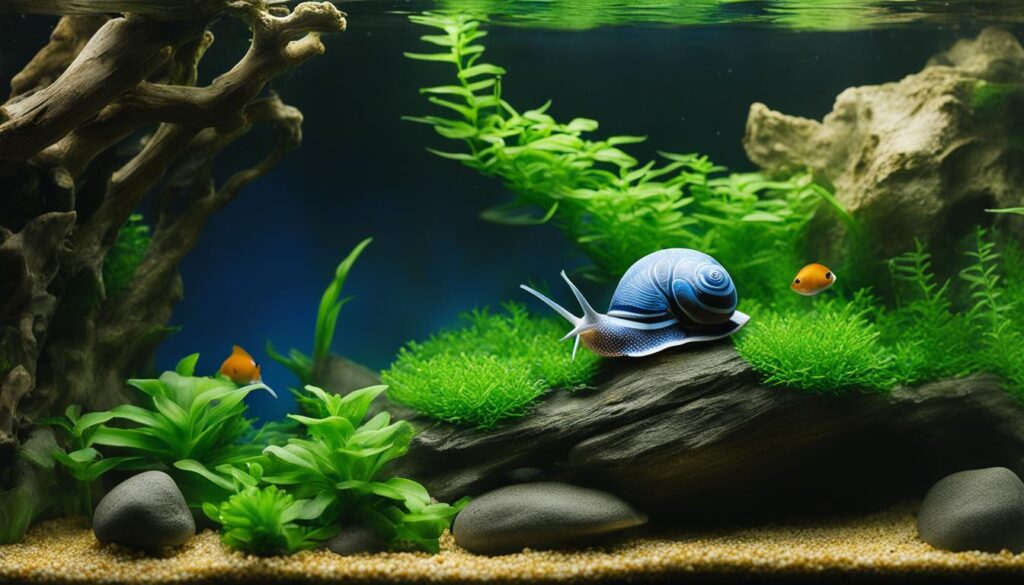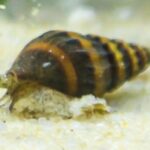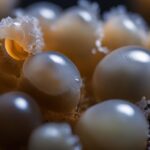Hello there! I’m Clint, coming to you from Snailmight, and I’m thrilled to dive into the uniquely rewarding world of the Blue Mystery Snail. These delightful aquatic critters are not only mesmerizing to watch but are also known for their gentle temperament and ease of care. I’ll be your guide through this comprehensive blue mystery snail care guide, where you’ll learn how to create the ideal snail habitat, and understand the fundamentals of snail husbandry to ensure your shelled companions thrive. So, let’s get our feet wet as we embark on this fascinating journey together!
Key Takeaways
- Discover what makes Blue Mystery Snails a delightful addition to any aquarium.
- Learn about the essentials of crafting an ideal snail habitat for these serene creatures.
- Understand the significance of proper snail husbandry for your Blue Mystery Snail’s well-being.
- Gain insights into the easy-to-follow steps from this guide to caring for Blue Mystery Snails effectively.
- Embrace the joy and satisfaction of nurturing these peaceful mollusks in your home aquarium.
Introduction To Blue Mystery Snails
Embarking on the journey of starting a snail tank is a unique adventure, and one of the most captivating inhabitants you can choose is the Blue Mystery Snail. These aquarium snails are not just pets; they are a glimpse into the tranquil world beneath the water’s surface. Their serene beauty and active participation in the ecosystem make them a delightful presence in any aquatic setup.
As an enthusiastic aquarist myself, my first encounter with these mollusks was nothing short of magical. The way they glide across the tank, working diligently to clean algae, and their gentle interaction with other tank species, underscored why they deserve a spotlight in the realm of aquarium snails. In this blue mystery snail introduction, let’s unravel what makes these creatures a treasure for both novice and seasoned aquarium hobbyists alike.
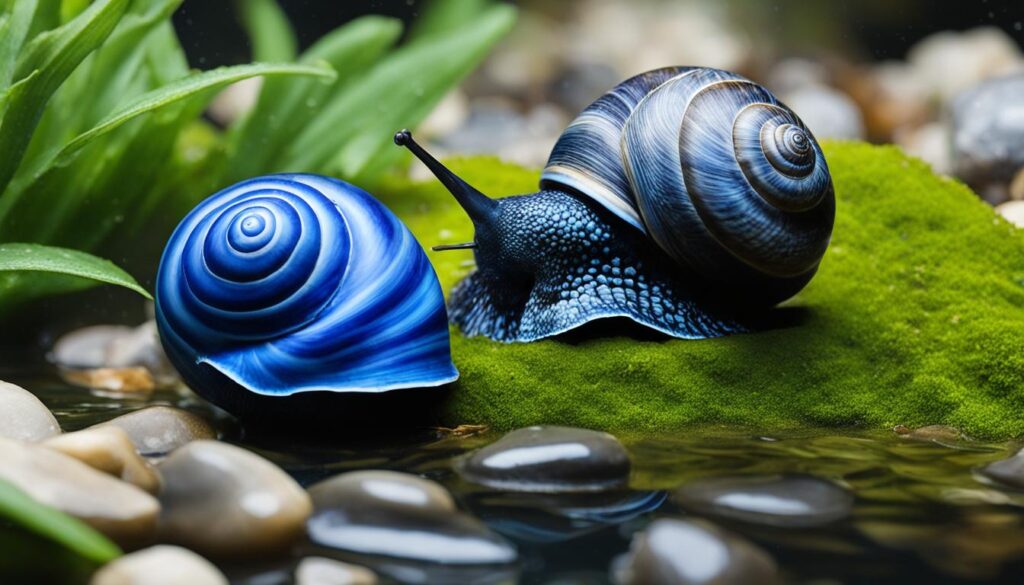
Their low maintenance requirements make starting a snail tank an accessible venture for many. With the slightest of care, Blue Mystery Snails can flourish, showing off their rich, sapphire-colored shells and adding a touch of elegance to any setup. But it’s not just aesthetics that they bring to the table; their personalities are surprisingly endearing, often lifting the curiosity and interest of onlookers as they explore every nook and cranny of their watery homes.
- Easy to maintain and care for
- Excellent algae eaters, keeping the tank clean
- Serene to watch, adding visual interest to your tank
- Peaceful nature, making them great community tank members
In the following sections, I’ll guide you through the enchanting process of starting a snail tank, ensuring that your Blue Mystery Snails not only survive but thrive. Stay tuned as we dive deeper into the requirements and rewards of keeping these mesmerizing creatures.
Understanding The Blue Mystery Snail
As an aficionado of the aquarium world, I’m always excited to share the fascinating intricacies of aquatic species, particularly the Blue Mystery Snail. Its allure lies not only in its vibrant coloration but also in its unique origin and behavior that have garnered it acclaim in the snail community. Let’s dive deeper to understand more about this charming creature’s background, the reasons for its popularity, and what we can expect in terms of longevity and growth.
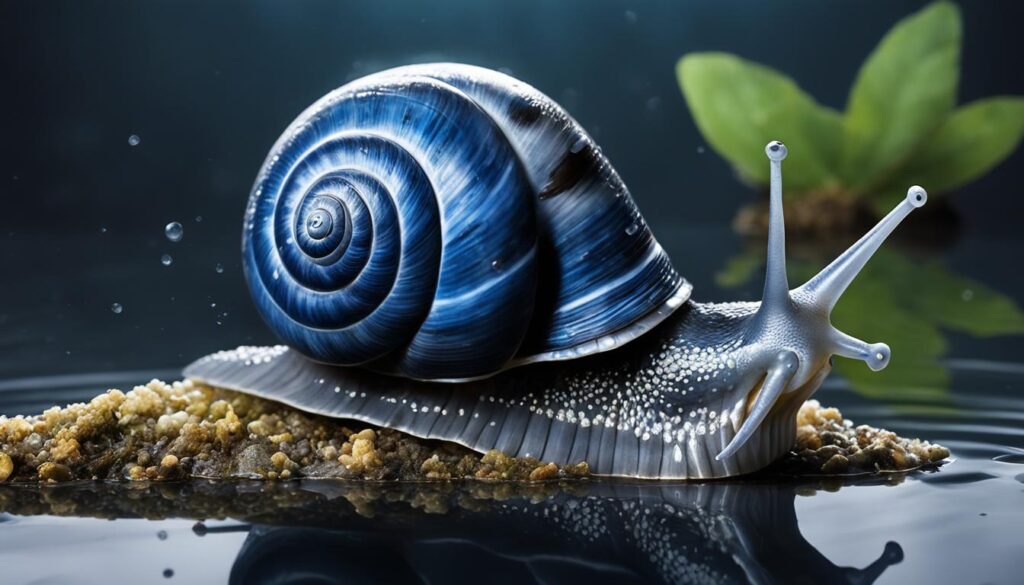
The Blue Mystery Snail’s Origin and Species Overview
The origins of the Blue Mystery Snail, scientifically known as Pomacea bridgesii, trace back to the freshwater bodies of South America. These snails belong to the Ampullariidae family, renowned for their diverse snail species origin and amphibious nature. Given their South American roots, these snails have adapted to both aquatic and terrestrial surroundings, although they flourish best in well-maintained freshwater tanks.
Why Blue Mystery Snails Are Popular Among Aquatic Enthusiasts
The popularity of mystery snails, especially our blue-hued companions, stems from their peaceful demeanor and minimal care requirements. They are a favorite among beginners and seasoned aquarists alike for their ability to coexist with a wide range of tank mates and their contribution to tank cleanup by feeding on algae and detritus. Their tranquil movement and intriguing behavior are a spectacle in any aquarium.
Life Expectancy and Growth Patterns
Understanding a snail’s life expectancy is pivotal for proper snail husbandry. Blue Mystery Snails boast a lifespan ranging between one to three years, influenced heavily by their living conditions. They tend to grow rapidly, reaching their adult size of about two inches in diameter provided they live in optimal conditions with sufficient nutrition and clean water.
| Age | Size | Notes |
|---|---|---|
| 1 month | 0.25 inches | At this stage, proper calcium intake is crucial for shell development. |
| 3 months | 0.5 – 0.75 inches | Regular water changes are recommended to facilitate growth. |
| 6 months | 1 – 1.25 inches | Snails start to show their distinctive blue color. |
| 1 year | Up to 2 inches | Adult size reached; snails are now more resilient to changes. |
Setting Up The Perfect Habitat
Creating a snail habitat for the Blue Mystery Snail goes beyond placing a shell in water. It requires careful consideration of space, substrate, and the overall mystery snail environment. Let me guide you through the essentials of curating an enriching snail aquarium setup to ensure your aquatic companions flourish.
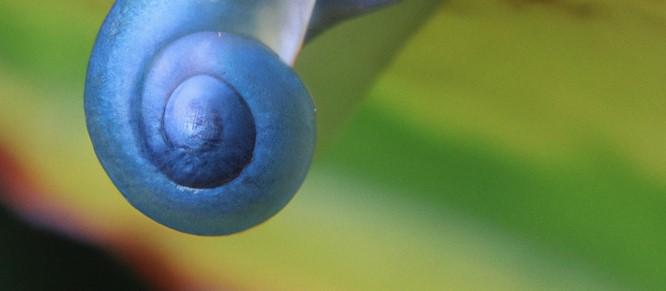
When I began my journey into snail husbandry, I quickly realized that tank size is a critical starting point. A spacious home is not just about comfort; it’s about providing ample room for exploration and growth. I recommend a minimum of a 10-gallon tank for a small group of mystery snails to promote a healthy, active lifestyle.
Remember, the key to creating a perfect home is replicating their natural environment as closely as possible to encourage normal behavior and reduce stress.
The substrate is not to be overlooked either. Choose a substrate that mimics the soft, riverbeds that mystery snails are accustomed to. Sand or fine, smooth gravel will not only cater to their burrowing instincts but also prevent any injuries that coarse substrates could cause.
Here’s a breakdown of the other elements vital for your snail aquarium setup:
- Filtration: Use a filter with gentle water flow to keep the water clean without creating strong currents that can disorient your snails.
- Plants: Live plants not only enhance the aesthetic of the tank but also provide hiding spaces and contribute to water quality.
- Decoration: Offer structures like driftwood or caves for climbing and resting, adding to the dynamic of your mystery snail environment.
- Water Quality: Always maintain pristine water conditions, with regular checks on ammonia, nitrites, and nitrates levels to prevent health issues.
In all my years of maintaining snail habitats, I’ve found that consistency is key. A stable environment allows mystery snails to exhibit their best colors, behaviors, and longevity. With these tips in mind, you’re well on your way to creating a haven that your Blue Mystery Snails can proudly call home.
Optimal Water Conditions for Blue Mystery Snails
As someone deeply passionate about snail husbandry, I can’t stress enough the importance of maintaining precise water parameters for snails to keep our shelled friends healthy and happy. Being meticulous about snail water quality can greatly impact the longevity and vitality of your Blue Mystery Snails. Let’s dive into the specifics that will ensure an optimal aquatic setting for these captivating creatures.
Water Parameters: Temperature, pH, and Hardness
The water in which Blue Mystery Snails thrive has to be just right. They are quite particular about their environment, so checking the water’s temperature, pH, and hardness regularly is a cornerstone of effective aquarium water maintenance. Here’s a breakdown of these crucial water quality parameters:
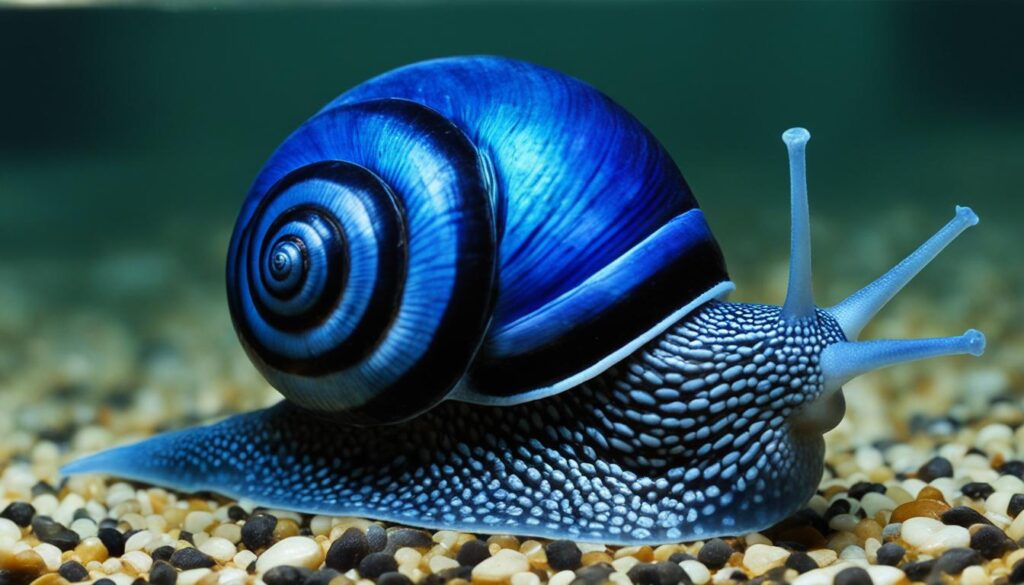
| Parameter | Optimal Range | Significance |
|---|---|---|
| Temperature | 68°F to 82°F (20°C to 27°C) | Maintains snail’s metabolic rate |
| pH | 7.0 to 7.5 | Ensures proper shell growth and health |
| Hardness (GH) | 8 to 18 dGH | Provides essential minerals for shell development |
How to Maintain High-Quality Water
Establishing ideal water conditions is one thing, but the ongoing quest to maintain that purity is what truly makes a difference for your snails’ welfare. Regular water changes and tests are non-negotiable routines. I recommend replacing at least 25% of the tank water bi-weekly, complemented by weekly testing of pH levels and water hardness. Incorporate a water conditioner that removes chlorine and chloramines, and consider using a buffering substrate to stabilize pH levels.
An often-overlooked aspect of water quality is the accumulation of uneaten food and snail waste, which can lead to increased levels of ammonia and nitrates. It’s a must to include a filtration system that can handle the bioload of your tank. A balanced diet also plays a role; feeding your snails the right amount ensures there’s less waste to pollute their environment.
By following these steps meticulously, you’ll create a sanctuary for your Blue Mystery Snails, where the water is not only life-sustaining but life-enhancing, allowing them to flourish in all their blue-hued glory.
Diet and Feeding Requirements
Ensuring a proper snail diet for your blue mystery snails is not just a matter of dropping in food and hoping for the best; it’s about understanding the delicate balance of snail nutrition. Like many pets, feeding blue mystery snails requires a blend of knowledge and consistency. Let’s dive into their nutritional needs and what constitutes a balanced meal for these gentle creatures.
Understanding Blue Mystery Snail Nutritional Needs
Blue mystery snails are voracious feeders, and their dietary requirements can be surprisingly varied. A blend of plant-based materials, proteins, and minerals helps them maintain a strong shell and overall good health. Calcium, in particular, is crucial for shell growth, making it an essential part of the snail diet. Let’s take a look at what to feed these hungry snails to keep them happy and healthy.
Best Feeding Practices and Foods
When it comes to feeding blue mystery snails, consistency and variety are key. They are not picky eaters, but they thrive on a balanced diet that includes:
- Algae wafers
- Blanched vegetables such as zucchini, carrots, and spinach
- High-calcium foods for shell health
- Pellets or fish food formulated for snails
It’s best to feed your snails one to two times daily, removing any uneaten food after 24 hours to maintain water quality.
What To Avoid Feeding Your Blue Mystery Snail
Just as important as what to feed your snail is what to avoid. Some foods can be harmful to their health or mess with the balance of your tank. Avoid:
- Citrus fruits and other acidic foods
- Food with high salt content
- Decomposing leftovers which can deteriorate water quality
Monitoring your snail’s growth and health is a good indicator of whether the diet suits their needs.
| Food Type | Benefits | Frequency |
|---|---|---|
| Algae wafers | Easy to consume, rich in nutrients | 2-3 times per week |
| Blanched vegetables | High in fiber, essential vitamins, and minerals | 2-3 times per week |
| High-calcium foods | Crucial for shell strength and snail growth | Daily in small amounts |
| Snail-specific pellets | Formulated to meet snail dietary needs | 1-2 times per week |
Keep in mind, a diverse snail diet supports overall snail nutrition, promoting longevity and vitality. With these feeding guidelines, your blue mystery snails will not only survive but thrive in their aquatic home.
Common Health Issues and Prevention
As an enthusiast in snail health and care, it’s important to me that we address not only the charm of the Blue Mystery Snails but also the potential health issues they may encounter. Despite our best efforts in preventing snail diseases, ailments can arise that challenge the snail wellness we strive for. Let’s dive into the common health concerns and the tactics we can deploy to preemptively tackle them.
Shell deterioration, for instance, is a clear sign your snail might be in distress. This could be a result of acidic water conditions or a lack of calcium in their diet, which are critical for maintaining a healthy shell. Observing your snail’s shell regularly for any unusual pitting or thinning is essential.
- Monitor water pH levels to ensure they stay within the ideal range for snails.
- Incorporate calcium-rich foods or even add a cuttlebone to your tank to supplement their intake.
Another issue to keep an eye out for is parasitic infections. While some parasites are a natural part of a snail’s ecosystem, an overabundance can be harmful. Symptoms such as lack of appetite, sluggish movement, or unusual shell growth could indicate the presence of unwanted guests.
- Keep their habitat clean by performing regular water changes.
- Quarantine any new aquatic plants or decorations that may introduce parasites to the tank.
- Regularly inspect your snails and their tankmates for signs of parasitic activity.
Keeping Blue Mystery Snails healthy is a labor of love that requires attentiveness and proactive measures. By recognizing and addressing health issues early on, we contribute to a sustainable environment where our snails can thrive in wellness.
Let’s continue to prioritize the health of our snail friends as we do our own, because ensuring their well-being is as fulfilling as it is a responsibility. After all, a healthy snail is a happy snail, and a happy snail makes for a delightful aquatic companion.
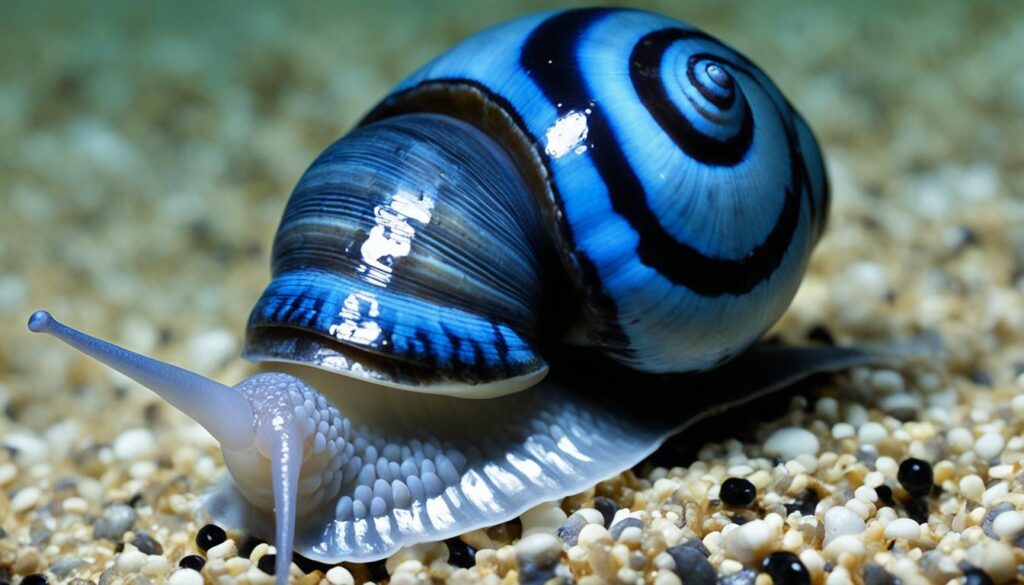
Tankmates for Blue Mystery Snails
Creating a vibrant and cohesive aquatic community is exciting, and when it comes to my Blue Mystery Snails, ensuring they have suitable tankmates is critical for a harmonious existence. Ensuring compatibility among aquarium species not only contributes to a peaceful tank but can also enhance the overall ecosystem’s health and visual appeal.
Compatible Aquatic Species
When selecting snail tankmates, look for non-aggressive species that thrive in similar water conditions. I’ve found that certain fish and invertebrates make the best companions for Blue Mystery Snails. Here’s a straightforward guide to help you choose compatible aquarium species:
| Species Type | Compatibility | Notes |
|---|---|---|
| Tetras | High | Peaceful schooling fish that are indifferent to snails. |
| Shrimp (e.g., Cherry Shrimp) | High | They coexist well with snails, often sharing food. |
| Corydoras Catfish | High | Bottom-dwellers that maintain a respectful distance from snails. |
| Loaches (e.g., Kuhli Loach) | Moderate | Generally peaceful but may nip at snails if not well-fed. |
| Otocinclus | High | Algae eaters that pose no threat to snails. |
Tips for Introducing New Tankmates
Introducing snail companions should be done with care to ensure a smooth transition and prevent stress to your aquatic pets. Here are some personal tips that have helped me successfully integrate new tankmates:
- Quarantine New Arrivals: Always quarantine new fish or invertebrates for a couple of weeks to prevent the spread of diseases to your snails.
- Check for Compatibility: Before introducing a new species, research their temperament and environmental needs to ensure they won’t conflict with your snails.
- Monitor Interactions: After introduction, observe the tank closely for a few days to confirm that there are no aggressive interactions.
- Provide Adequate Space: A spacious tank reduces competition for food and territory, promoting peace among tankmates.
Whether you’re just starting with your snail aquarium or looking to add more diversity, remember that an informed choice when introducing snail companions is key. With these tips and considerations, I’ve cultivated a thriving snail habitat filled with harmonious interactions and serene beauty.
Conclusion
In our journey exploring the enchanting world of the Blue Mystery Snail, we’ve covered a spectrum of topics, each contributing to a solid foundation in successful snail keeping. From understanding their origins and specific needs to crafting the ideal habitat, it’s my hope that this guide has illuminated a clear path for both newcomers and seasoned hobbyists alike. By adhering to the detailed insights provided on water parameters, dietary essentials, and companionable tankmates, you’re well on your way to curating an underwater haven teeming with health and vitality.
The care for these serene creatures is more than just a routine—it’s an enriching experience that blossoms with patience and dedication. In considering the concluding snail care steps outlined in this article, remember that each choice you make impacts the thriving ecosystem in your tank. Regular monitoring and adjustments go hand-in-hand with responsive and informed decision-making, ensuring that your aquatic friends flourish.
As we reminisce on our final thoughts on Blue Mystery Snails, it is apparent that their upkeep, while indeed a commitment, is a truly rewarding endeavor. The calm they introduce into your aquatic ensemble, coupled with their low-maintenance disposition, reinforces the joy and tranquility that aquarium life brings. Aim to build upon what you’ve learned here; let your curiosity and passion for snail husbandry guide you towards an ever-evolving mastery in the art of keeping Blue Mystery Snails.

